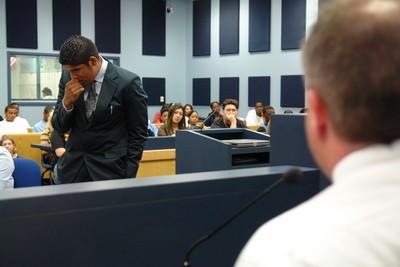Legal Lessons

High school janitor Al Johnson lies "dead" center stage of the theater.
All eyes look toward teacher Adam Sutherland as the key suspect in the "murder."
The weapons: a hammer and a screwdriver.
The motive: money.
Teachers and students at Canyon Springs High School have bound together for a co-curricular, educational experience. The forensics science, mock trial and legal debate, and street law classes have designed a project in which students begin with a crime scene and end with a complete trial and verdict.
"A lot of schools do mock trial and a lot of schools do forensics crime scenes," said forensics science teacher Don Nordstrom. "But this is the first time in the nation that the two have come together."
Nordstrom’s students have been preparing all school year for this project. The students have been learning subject matter only seen in television shows such as "CSI" and "Law and Order." Most importantly, they have learned how to analyze hair and fingerprints samples, and on the legal side, how to write affidavits, question suspects and obtain search warrants.
"We learned both the legal and scientific aspect of putting a criminal away," said forensics student Andrew Defelice.
Defelice is the lead questioner and legal coordinator between the forensics and mock trial classes. His job as lead questioner includes making sure his investigation team asks the proper questions of suspects and witnesses and that they write detailed affidavits of their findings throughout the investigation. As legal coordinator, he brings newly discovered evidence to the mock trial prosecution team.
"I especially enjoy this job because working with the prosecution helps me learn more about the law and the Constitution and I can relay that back to my investigation team," Defelice said.
The team learned a hard lesson about the legal system when one of the investigators mistakenly forgot to read one of the suspects his Miranda rights.
"Luckily for us, the suspect had not said anything that would have played a key factor in the case," Defelice said.
Once the forensics investigators gather all of the evidence, they deliver it to the mock trial team members so they can begin developing the case. Heading the mock trial class is teacher Stacie Anthony. Her class prepared for the project through their participation in the mock trial competition in January.
"My students’ roles in the project are the prosecutors who bring the charges and the defense team who defend the suspect," Anthony said.
The mock trial students and Anthony especially enjoy this project because they like working with the different classes and bringing all the information together from scratch.
"Cross curricular instruction is very beneficial to students so they can see how life in the real world is interconnected," Anthony said.
The trial began May 1 and lasted through May 3 with Canyon Springs’ government teacher David Eason, who is a former lawyer, playing the role of judge.
On the first trial day, the street law students took their place on the jurors’ bench and the mock trial team prepared for jury selection. Both the prosecution and the defense receive three peremptory strikes, meaning they could each eliminate three potential jurors.
"The jury selection went really well for our first time doing it," said student Jesse DeLeon. "It was interesting coming up with questions to determine (the jurors’) bias and hearing some of their responses."
Over the next two days, the students prepared opening statements, performed direct and cross-examinations and closing statements. They were able to use exhibits in court to outline the crime scene for the jury provided by the computer assisted drafting and design class and also video interviews provided by broadcast journalism students.
One of the most important witnesses in the trial was teacher Kelly Loignon who confessed to helping Sutherland with the murder. She received a plea bargain from the prosecution team and agreed to serve a five-year prison term for manslaughter.
Once the trial ended, the jury was given instructions from Eason. The jury was to choose between first-degree murder, manslaughter and innocent. The mock trial participants and the forensics teams waited in anticipation as the jury deliberated. At the end of deliberation the jury reached a guilty verdict and sentenced Sutherland to the maximum 20 years in prison for manslaughter.
Nordstrom said he wants to start a tradition at Canyon Springs and re-create this co-curricular project next year.